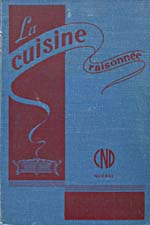|
In the 20th century, cooking adopted an increasingly scientific approach, and concern about proper nutrition began to assume a more central role.
With the introduction of gas and electric stoves, electric refrigerators, canned goods, preserving jars and various gadgets during the first few decades of the century, it became easier to prepare a wider range of dishes. It was expected that these aids, along with the home delivery of bread, milk and butter, would make life easier for women. Instead, household standards were raised, and housewives were expected to do more. Since servants were no longer deemed necessary for most people, the burden on the homemaker actually increased.
With food options gradually becoming less dependent on what was seasonally available, the sense that there was a right time to eat various fruits and vegetables began to be lost, and with it some of the enjoyment of the local harvest.
Nineteenth-century teacher Amy Richards dedicated her book to her many pupils. She noted that a great deal of attention was given at the time to the subject of cookery, yet many were still woefully ignorant of that important household art.
|
 Source
Source
|
|
|
Amélie DesRoches. Hygiène de l'alimentation et propriétés chimiques des aliments. Neuville, Que.: s.n., 1912
|
The aim of this little book, published in 1912, was to instruct young girls in the art of healthy cooking. "In this work, I have omitted anything fantastic in nature; this book is, above all, useful and practical" [translation] (p. vii).
|
 Source
Source
|
|
 Source
Source
|
|
Nellie Lyle Pattinson. Canadian Cook Book. 4th ed. Toronto: Ryerson Press, 1927
|
Nellie Pattinson's cookbook, first published in 1923, satisfied a demand for a recipe book that could be conveniently used by teachers and students in technical schools. Pattinson was one of the first authors to refer to the new science of nutrition. Her book, still in print, has been republished in updated versions every few years.
|
 Source
Source
|
|
 Source
Source
|
|
Congrégation de Notre-Dame. La cuisine raisonnée. 4th ed. Québec: Congrégation de Notre-Dame, 1943
|
The existence of vitamins (unrelated chemical substances that are all necessary for life) is one the most significant discoveries of our century. The word vitamin comes from the Latin vita, meaning life.
|